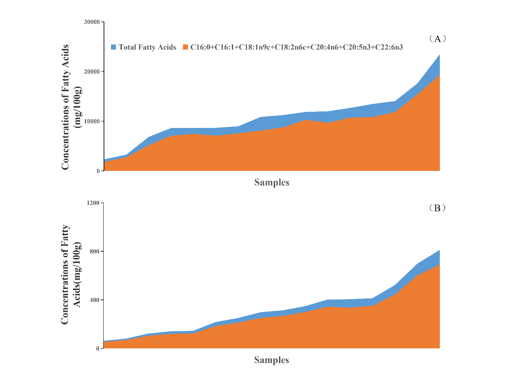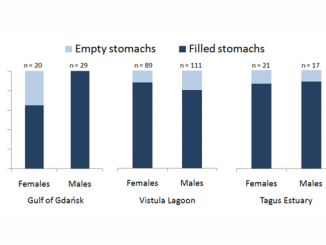
Paper category: Original research paper
Corresponding author: Chao Song (songc@ffrc.cn)
DOI: 10.2478/oandhs-2021-0029
Received: 05/11/2020
Accepted: 11/01/2020
Full text: here
Citation (APA style): Zou,J.,Song,C.,Meng,S.,Hu,G.,Qiu,L.,Fan,L. & Chen,J.(2021).Effects of feed on fatty acid composition in muscles and gonads of the Chinese mitten crab (Eriocheir sinensis). Oceanological and Hydrobiological Studies,50(3) 338-351. https://doi.org/10.2478/oandhs-2021-0029
Abstract
In this study, the effects of different feeds on fatty acid composition in the Chinese mitten crab (Eriocheir sinensis) were investigated. The fatty acid composition in the Chinese mitten crab was significantly correlated with the type of feed source provided. Differences between the feed groups pertained mainly five fatty acids: oleic acid, linoleic acid, palmitic acid, eicosapentaenoic acid (EPA) and docosahexaenoic acid (DHA). The content of EPA and DHA was higher in the group of frozen trash fish than in the group of formulated feed. On the other hand, the content of oleic acid, linoleic acid and palmitic acid was higher in the formulated feed group than in the frozen trash fish group. There were significant differences in the nutritional value of the Chinese mitten crab reared under different feed sources, i.e. Chinese mitten crabs reared with the frozen trash fish feed were larger than those reared with the formulated feed, especially as regards the ω-3/ω-6 PUFA ratio and essential fatty acid levels.
Conclusion
The Chinese mitten crab is a high-quality aquatic product of China, ranking as an important product in China’s aquaculture industry. The content of ω-3 PUFAs, such as EPA and DHA, is higher in crabs receiving frozen trash fish than in crabs from the formulated feed group. Fatty acids in crabs are significantly correlated with the feed composition. The oleic acid, linoleic acid, palmitic acid, EPA, and DHA are mainly affected by substituting trash fish feed for formulated feed, these fatty acids, to a certain extent, represent the nutritional value of Chinese mitten crabs. Compared with the frozen trash fish feed group, the level of the aforementioned fatty acids in the formulated feed group could reach a similar level by adding exogenous ω-3 PUFA to the formula. Thus, further research to improve the formula can significantly contribute to the promotion of environmentally friendly aquaculture.
Acknowledgements
This work was supported by the Central Public-Interest Scientific Institution Basal Research Fund, the Freshwater Fisheries Research Center, CAFS (No. 2019JBFZ04) and the Project of Fishery Science and Technology in the Jiangsu province (D2018-04).
References
Bureau of Fisheries, Ministry of Agriculture and Rural Affairs of China. (2017). 2017 China Fishery Statistical Yearbook. China Agriculture Press, Beijing.
Cao, L., Naylor, R., Henriksson, P., Leadbitter, D., Metian, M. et al. (2015). Chinas aquaculture and the worlds wild fisheries. Science 347(6218): 133–135.
Chen, D.W., Zhang, M. & Shrestha, S. (2007). Compositional characteristics and nutritional quality of Chinese mitten crab (Eriocheir sinensis). Food Chemistry 103(4): 1343–1349.
China Food and Drug Administration. (2016). GB5009.168-2016 Quantitation of fatty acids in foods. Standards Press of China.
China Fisheries Bureau. (2020). China Fisheries Statistics Yearbook 2020. (In Chinese).
Chinese Nutrition Society (2000). Chinese Dietary Reference Intakes Acta Nutrimenta Sinica 23(6): 193–196.
Çelik, M., Türeli, C., Çelikm M., Yanar, Y., Erdem, Ü. et al. (2004). Fatty acid composition of the blue crab (Callinectes sapidus Rathbun, 1896) in the north eastern Mediterranean. Food Chemistry 88(2): 271–273.
Elagizi, A., Lavie, C.J., Marshall, K., DiNicolantonio, J.J., O'Keefe, J.H. et al. (2018). Omega-3 Polyunsaturated Fatty Acids and Cardiovascular Health: A Comprehensive Review. Progress in Cardiovascular Diseases 61(1): 76–85. DOI: 10.1016/j.pcad.2018.03.006.
Ge, Y.C., Jiang, X.D., Zhang, J.B., Wu, X.G., Deng, D. et al. (2017). Effects of Formulated Feed and Fresh Iced trash fish on Gonadal Development and Approximate Composition of Chinese Mitten Handed Crab Eriocheir sinensis in a Pond Culture. Fisheries Science 36(5): 551–556.
General Administration of Quality Supervision, Inspection and Quarantine of the People's Republic of China. (2008). GB/T21514-2008 Determination of the content of fatty acides in feeds Standards Press of China.
Han, D., Shan, X., Zhang, W., Chen, Y., Wang, Q. et al. (2018). A revisit to fishmeal usage and associated consequences in Chinese aquaculture. Reviews in Aquaculture 10: 493–507.
Harper, C.R. & Jacobson, T.A. (2005). Usefulness of Omega-3 Fatty Acids and the Prevention of Coronary Heart Disease. The American Journal of Cardiology 96(11): 1521–1529. DOI: 10.1016/j.amjcard.2005.07.071.
Hasan, M.R. & Halwart, M. (Eds.) (2009). Fish as feed inputs for aquaculture. Practices, sustainability and implications. In FAO Fisheries and Aquaculture Technical Paper Vol. 518, 426 pp.
He, J., Wu, X.G., Zhao, H.L., Jiang, X.D., Ge, Y.C. et al. (2016). Growth performance and gonadal development of pond-reared Chinese mitten crab (Eriocheir sinensis) fed formulated diets during the whole culture process. Journal of Fishery Sciences of China 23(3): 606–618.
Jankowska, B., Zakęś, Z., Żmijewski, T. & Szczepkowski, M. (2010). Fatty acid profile of muscles, liver and mesenteric fat in wild and reared perch (Perca fluviatilis L.). Food Chemistry 118(3): 764–768.
Jian, Z., Liping, M., Yuanrong, J., Chunrong, W., Tieying, Z. et al. (2009). The Dietary Fatty Acids Intakes and Their Food Sources Among Chinese Adults. Acta Nutrimenta Sinica 31(5): 424–427.
Kan, Y.Q. (2012). Effects of dietary containing various oil ratios in formulated dites on growth, body composition and degestive enzymes of Chinese mitten crab (Eriochier sinensis). Unpublished Master Thesis, Shanghai Ocean University.
Kong, L., Cai, C., Ye, Y., Chen, D., Wu, P. et al. (2012). Comparison of non-volatile compounds and sensory characteristics of Chinese mitten crabs (Eriocheir sinensis) reared in lakes and ponds: Potential environmental factors. Aquaculture 364–365: 96–102. DOI: 10.1016/j.aquaculture.2012.08.008.
Li, J., Lu, H., Zhu, J., Wang, Y. & Li, X. (2009). Aquatic products processing industry in China: Challenges and outlook. Trends in Food Science & Technology 20(2): 73–77. DOI: 10.1016/j.tifs.2008.09.008.
Li, X.G., Zhoug, G., Zhang, T.Q., Zhou, J., Lin, H. et al. (2011). Effects of different feed on general nutrient composition of Chinese mitten crabs. Jiangsu Agricultural Sciences 39(4): 410–412.
Liping, M., Jian, Z., Chunrong, W., Tieying, Z., Yuanrong, J. et al. (2009). Study on the Dietary Fatty Acids Intake among Middle-aged and Aged People in China. Food and Nutrition in China (10): 58–61.
Liu, Q., Liu, H., Wu, X.G. & He, J. (2015). Genetic variation of wild and cultured populations of Chinese mitten crab Eriocheir Sinensis from the Yangtze, Huanghe, and Liaohe River Basins using microsatellite marker. Oceanologia Et Limnologia Sinica 46(4): 958–968.
Muskiet, F.A.J., van Goor, S.A. & Kuipers, R.S. (2006). Long-chain polyunsaturated fatty acids in maternal and infant nutrition. Prostaglandins, Leukotrienes and Essential Fatty Acids 75(3): 135–144. DOI: 10.1016/j.plefa.2006.05.010.
Nettleton, J.A. (1995). Omega-3 Fatty Acids and Health. Springer US, New York.
Osmond, A.T.Y. & Colombo, S.M. (2019). The future of genetic engineering to provide essential dietary nutrients and improve growth performance in aquaculture: advantages and challenges. Journal of the World Aquaculture Society 50 (2019): 490–509.
Que, Y.Q., Yang, Z.G., Cheng, Y.X., Chen, Z.G. & Wang, J. (2011). Formulated feed as substitute for mixed fishes and other natural feeds in rearing of Chinese mitten crabs. Scientific Fish Farming (12): 64–65.
Que, Y.Q., Yang, Z.G., Ji, L.Y., He, J., Shao, L.C. et al. (2012). Effects of formulated dietary replacement of trash fish on growth performance,body composition and fatty acid composition of Eriocheir sinensis. Journal of Fisheries of China 36(10): 1612–1623.
Rhee, J.J., Kim, E., Buring, J.E. & Kurth, T. (2017). Fish Consumption, Omega-3 Fatty Acids, and Risk of Cardiovascular Disease. American Journal of Preventive Medicine 52(1): 10–19. DOI: 10.1016/j.amepre.2016.07.020.
Roynette, C.E., Calder, P.C., Dupertuis, Y.M. & Pichard, C. (2004). n-3 Polyunsaturated fatty acids and colon cancer prevention. Clinical Nutrition 23(2): 139–151. DOI: 10.1016/j.clnu.2003.07.005.
Shao, L.C. (2012). Nutritional quality and sensory evalution of fattening empty Chinese mitten crab with formulated diet and trash fish. Unpublished Master Thesis, Shanghai Ocean University.
Shoda, R., Matsueda, K., Yamato, S. & Umeda, N. (1996). Epidemiologic analysis of Crohn disease in Japan: increased dietary intake of n-6 polyunsaturated fatty acids and animal protein relates to the increased incidence of Crohn disease in Japan. American Journal of Clinical Nutrition 63(5): 741–745.
Sui, L., Wille, M., Cheng, Y. & Sorgeloos, P. (2007). The effect of dietary n-3 HUFA levels and DHA/EPA ratios on growth, survival and osmotic stress tolerance of Chinese mitten crab Eriocheir sinensis larvae. Aquaculture 273(1): 139–150. DOI: 10.1016/j.aquaculture.2015.01.010.
Tang, C.Q., Fu, N., Wang, X.C., Tao, N.P. & Liu, Y. (2014). Comparison of fatty acid composition in Eriocheir sinensis cultured by purse net and pond. Freshwater Fisheries 44(1): 84–89.
Teng, Y.M., Cheng, Y.X., Wu, X.G., Yang, X.Z., Bian, W.J. et al. (2008). A comparative study on some biological index changes concerned with gonad development between two population of the Chinese mitten crab (Eriocheir sinensis): Rhine and Yangtze. Journal of Shanghai Ocean University 17(1): 65–71.
Tocher, D.R. (2015). Omega-3 long-chain polyunsaturated fatty acids and aquaculture in perspective. Aquaculture 449: 94–107. DOI: 10.1016/j.aquaculture.2015.01.010.
Tocher, D.R., Betancor, M.B., Sprague, M., Olsen, R.E., Napier, J.A. (2019). Omega-3 Long Chain Polyunsaturated Fatty Acids, EPA and DHA: Bridging the Gap between Supply and Demand. Nutrients 11(2019): 89.
Tur, J.A., Bibiloni, M.M., Sureda, A. & Pons, A. (2012). Dietary sources of omega 3 fatty acids: public health risks and benefits. British Journal of Nutrition 107(S2): S23–S52. DOI: 10.1016/j.foodchem.2015.12.093.
Turchini, G.M. , Torstensen, B.E. & Ng, W.K. (2010). Fish oil replacement in finfish nutrition. Reviews in Aquaculture 1(1): 10–57.
Wang, S., He, Y., Wang, Y., Tao, N., Wu, X. et al. (2016). Comparison of flavour qualities of three sourced Eriocheir sinensis. Food Chemistry 200: 24–31. DOI: 10.1016/j.foodchem.2015.12.093.
Wang, J.Y., Yang, Z.G., Wei, B.H., Shi, Q.Y., Yang, X.Z. et al. (2017). Effects of different lipid sources on growth, digestive enzyme activity, and fatty acid composition in juvenile Chinese mitten crab, Eriocheir sinensis. Journal of Fishery Sciences of China 24(6): 56–65.
Wen, X.B., Chen, L.Q., Ai, C.X., Zhou, Z. & Jiang, H.B. (2001). Variation in lipid composition of Chinese mitten-handed crab, Eriocheir sinensis during ovarian maturation. Comparative Biochemistry & Physiology Part B Biochemistry & Molecular Biology 130(1): 95–104. DOI: 10.1016/S1096-4959(01)00411-0.
WHO/FAO. (1994). Fats and Oils in Human Nutrition. FAO Food and Nutrition Paper 57.
Wu, X., Chang, G.L., Cheng, Y., Zeng, C., Southgate, P.C. et al. (2010). Effects of dietary phospholipid and highly unsaturated fatty acid on the gonadal development, tissue proximate composition, lipid class and fatty acid composition of precocious Chinese mitten crab, Eriocheir sinensis. Aquaculture Nutrition 16(1): 25–36.
Wu, X., Wang, Z., Yong, X.C., Zeng, C., Yang, X. et al. (2011). Effects of dietary phospholipids and highly unsaturated fatty acids on the precocity, survival, growth and hepatic lipid composition of juvenile Chinese mitten crab, Eriocheir sinensis (H. Milne-Edwards). Aquaculture Research 42(3): 457–468.
Xu, H., Turchini, G.M., Francis, D.S., Liang M., Mock T.S. et al. (2020). Are fish what they eat? A fatty acid’s perspective. Progress in Lipid Research 80(2020).
Zhang, H., Zhang, J., Shang, X., Zhao, Y., Wu, Y. (2014) Fatty acids content of common marine fish from Yellow Sea of China. Journal of Hygiene Research. 43(3): 423–429.
Zhu, L.Y., Zhang, X.C., Song, X.J., Kuang, C.H. & Sun, Y.Z. (2007). Advances in n-3 polyunsaturated fatty acids DHA and EPA. Marine Sciences 31(11): 78–85.
Zhuang, K., Wu, N., Wang, X., Wu, X., Wang, S. et al. (2016). Effects of 3 Feeding Modes on the Volatile and Nonvolatile Compounds in the Edible Tissues of Female Chinese Mitten Crab (Eriocheir sinensis). Journal of Food Science 81(4): S968–S981.

